Explore Kyoto - Japan Travel, Asia
Welcome to Kyoto, the enchanting former capital of Japan that seamlessly blends ancient traditions with modern charm. Nestled in the Kansai region, Kyoto is renowned for its stunning temples, historic sites, and vibrant cultural heritage. Kyoto has something for everyone, whether you enjoy history, gastronomy, or environment. This Kyoto travel guide will take you through the essential aspects of Kyoto, from its rich history and cultural influence to its top attractions and must-try dishes.
Seeking a tailored Japan adventure? Explore our premium Japan tour offerings here.
Population: Approximately 1.5 million in 2023.
Economy: Home to information technology & electronics industry and other traditional crafts of Japan.
Landmarks: Kyoto Imperial Palace, Kinkaku-ji or the Golden Pavilion, and Kiyomizu-dera Temple─one of UNESCO World Heritage sites in Japan.
Japan
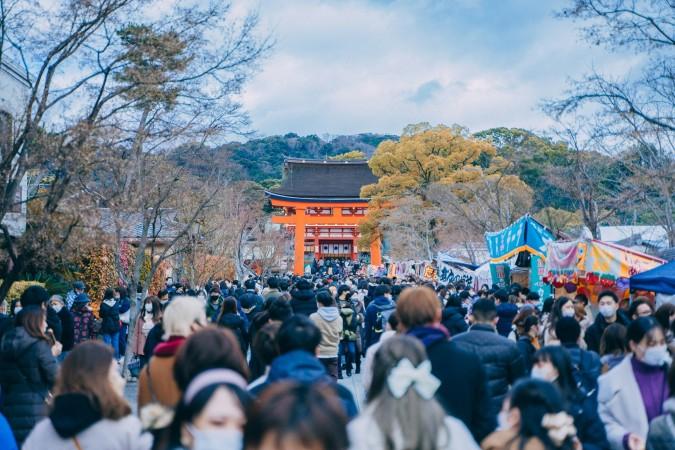
Overview of Kyoto
History & Cultural Influence
Kyoto, once the imperial capital of Japan for over a millennium, is a treasure trove of historical and cultural gems. The city’s history dates back to 794 AD when it became the seat of the imperial court. This period, known as the Heian era, marked the beginning of Kyoto's enduring legacy as a cultural hub. Today, Kyoto is home to over 2,000 temples and shrines, each telling a story of Japan’s rich past. Kyoto's cultural influence extends beyond its historical sites. The city is also a center for traditional Japanese arts, including tea ceremonies, flower arranging (ikebana), and calligraphy. Engaging with these practices offers a deeper understanding of Japan's artistic heritage.
Interaction with the Locals
Kyoto, a city rich in cultural heritage, has a population of approximately 1.5 million people. It is known for its historical significance and traditional architecture, attracting both residents and tourists. The population consists of a mix of locals and students, as Kyoto is home to several top universities in the country. Despite its modern advancements, Kyoto maintains a serene and traditional atmosphere, offering a unique blend of past and present.
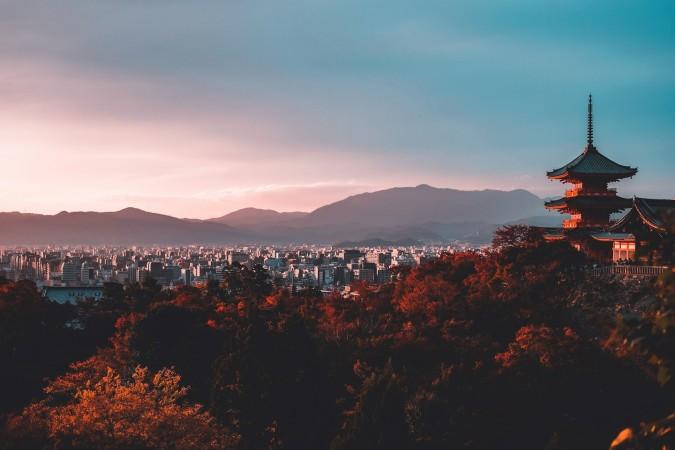
A Glimpse into Kyoto - © Su San Lee
Top Attractions in Kyoto
Kyoto’s top attractions are a testament to its historical and cultural richness. These must-visit places not only showcase the distinction of Kyoto’s historical and cultural heritage but also provide immersive experiences that leave a lasting impression on visitors.
- Kinkaku-ji (Golden Pavilion): As mentioned earlier, this dazzling temple is a must-see for its beauty and historical significance. The reflection of the Golden Pavilion on the surrounding pond creates a picturesque scene that is perfect for photography.
- Fushimi Inari Taisha: This shrine’s famous torii gates offer a unique hiking experience. As you walk through the seemingly endless gates, you’ll encounter smaller shrines and scenic viewpoints.
- Arashiyama Bamboo Grove: Stroll through the towering bamboo stalks of Arashiyama, a natural wonder that provides a tranquil escape from the city. The nearby Tenryu-ji Temple and the scenic Togetsukyo Bridge add to the area’s charm.
- Kiyomizu-dera Temple: Perched on a hillside, this UNESCO World Heritage site provides panoramic views of Kyoto. The temple’s wooden stage, which juts out from the main hall, is a marvel of engineering and a great spot for taking in the scenery.
- Nijo Castle: Built in 1603, this historical castle was the residence of Tokugawa Ieyasu, the first shogun of the Edo period. The castle's stunning grounds and detailed detailing of its Ninomaru Palace make for an interesting visit.
- Gion District: Famous for its traditional wooden machiya houses, this historic district is the heart of Kyoto’s geisha culture. Strolling through Gion in the evening, you might spot a geiko or maiko on their way to an appointment.
- Kyoto Imperial Palace: The former ruling palace of the Emperor of Japan, this grand structure is set within the spacious Kyoto Imperial Park. Guided tours are available, offering insights into the lives of Japan’s imperial family.
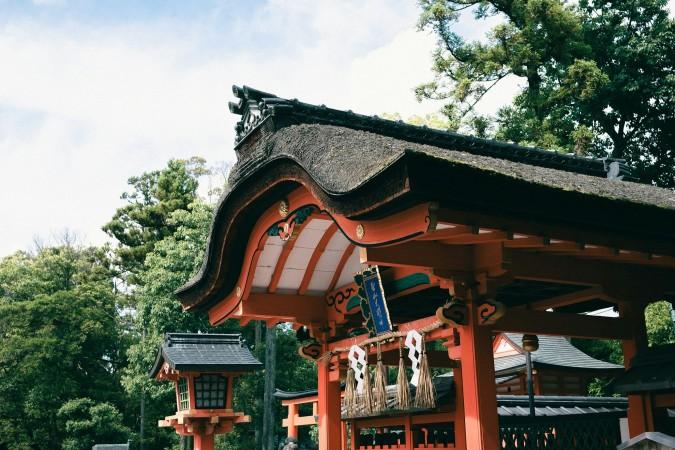
Fushimi Inari Taisha - © Gavin Li
Must-Try Dishes in Kyoto
Kyoto's cuisine is a delightful blend of tradition and innovation, offering a variety of dishes that reflect its rich cultural heritage. By tasting these iconic delights, visitors to Kyoto can experience the depth and diversity of the city's culinary heritage, each bite offering a taste of its rich history and cultural traditions.
- Kaiseki Ryori: This traditional multi-course dinner represents the pinnacle of Japanese haute cuisine. Kaiseki eating features seasonal ingredients, thorough preparation, and superb presentation. Each course, from the appetizers to the dessert, is a work of art, making it a memorable dining experience.
- Yudofu: A Kyoto specialty, Yudofu is a simple yet delicious dish featuring tofu simmered in a light broth. Often served with dipping sauces and garnishes, this dish highlights the delicate flavors and textures of tofu, making it a perfect winter comfort food.
- Obanzai: This traditional Kyoto home-cooking style features small dishes made with locally sourced ingredients. Obanzai dishes are often simple, seasonal, and healthful, providing a true taste of Kyoto's everyday cuisine.
- Kyo Wagashi: Kyoto is famous for its wagashi, or traditional Japanese sweets. These confections are often enjoyed with matcha tea and come in various shapes, colors, and flavors, reflecting the seasons and festivals.
- Nishin Soba: This dish features soba noodles served in a hot broth, topped with a sweet and savory simmered herring (nishin). Nishin soba is a traditional dish that highlights Kyoto's qualities and is popular in local soba restaurants.
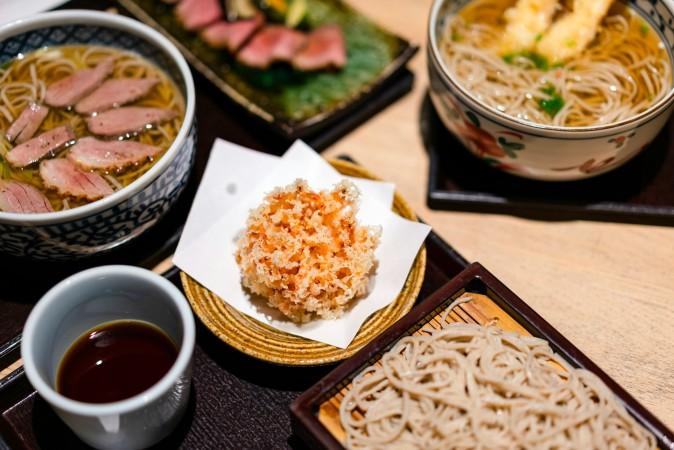
Kaiseki Ryori in Higashiyam, Kyoto - © White.Rainforest ™︎
Festivals & Local Celebrations
Kyoto's calendar is filled with vibrant festivals and local celebrations that offer a glimpse into the city's rich cultural traditions. Here are some of the most notable events:
Gion Matsuri
The most renowned event in Kyoto is Gion Matsuri, which takes place in July. It includes large parades with lavishly adorned floats, traditional music, and vibrant street celebrations. The festival's origins reach back to the ninth century, making it a deeply ingrained cultural event.
Aoi Matsuri
Aoi Matsuri is one of Kyoto's three major festivals which is held annually in May. The highlight is a procession featuring participants dressed in Heian-era costumes, which proceeds from the Kyoto Imperial Palace to the Kamo Shrines. The festival is named after the hollyhock leaves used in the decorations.
Jidai Matsuri
Known as the Festival of the Ages, Jidai Matsuri takes place in October and commemorates Kyoto's rich history. The procession includes participants dressed in costumes from various periods, from ancient to modern times, showcasing the evolution of Japanese culture.
Looking for more adventures? Dive into Matsumoto, another famous destination in Japan, with our article here.
Hanatouro
This enchanting event occurs in March and December, where lanterns illuminate the historic streets of Higashiyama and Arashiyama. The warm lighting of the lanterns creates a lovely environment that highlights the beauty of Kyoto's picturesque areas.
Gozan no Okuribi
Also known as the Daimonji Festival, this event is held in August and involves lighting large bonfires on the mountains surrounding Kyoto. The fires take the form of Chinese characters and other symbols, signaling the conclusion of the Obon celebration and leading ancestors' spirits back to the spirit realm.
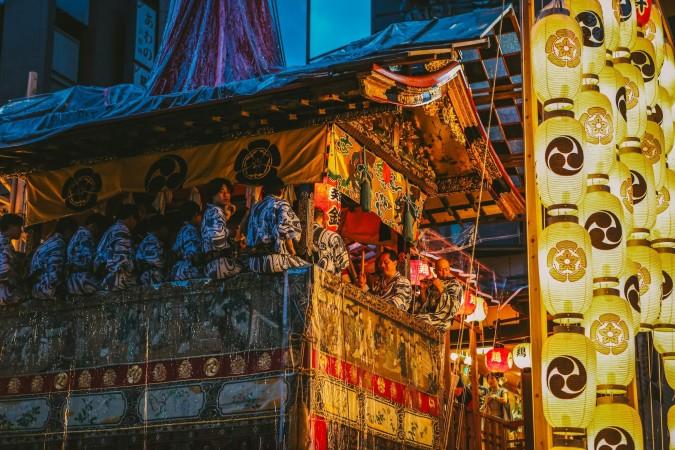
Gion Matsuri - © HANVIN CHEONG
Weather in Kyoto: Best Time to Visit
Kyoto experiences four distinct seasons, each offering a unique charm and atmosphere. Understanding the weather conditions can help you plan your visit to make the most of what Kyoto has to offer.
Spring in Kyoto
- Weather: Spring is one of the most popular seasons to visit Kyoto, with temperatures ranging from 10°C to 20°C (50°F to 68°F).
- Tourism Trend: The city is noted for its cherry blossoms, which bloom from late March to early April. Hanami (cherry blossom viewing) parties are a highlight, and many temples and gardens are adorned with pink blossoms, creating a picturesque setting.
Summer in Kyoto
- Weather: Summers in Kyoto are hot and humid, with temperatures often exceeding 30°C (86°F). The rainy season, known as tsuyu, occurs in June and early July, bringing occasional showers.
- Tourism Trend: Despite the heat, summer is vibrant with festivals such as Gion Matsuri. If you visit during this season, stay hydrated and take advantage of indoor attractions and evening activities.
Autumn in Kyoto
- Weather: Autumn is another ideal time to visit Kyoto, with temperatures ranging from 10°C to 25°C (50°F to 77°F). The city is renowned for its stunning fall foliage, which peaks in November.
- Tourism Trend: The vibrant reds, oranges, and yellows of the leaves provide a breathtaking backdrop to Kyoto's temples and parks, making camping or just simple photographing worth every penny.
Winter in Kyoto
- Weather: Winters in Kyoto are cold, with temperatures ranging from 0°C to 10°C (32°F to 50°F). Snowfall is quite common, adding a magical touch to the city's historic sites.
- Tourism Trend: Winter is a great time to enjoy Kyoto's hot springs (onsen) and warm dishes like yudofu. Or if you are planning for a well-ness retreat, this time of the year is also perfect for a spa, taking in the peaceful scene of the zen-garden or experiencing a traditional Japanese tea ceremony.
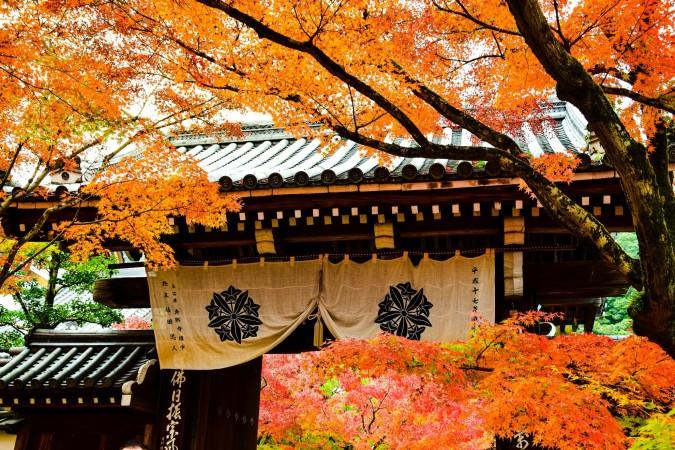
Autumn in Kyoto - © AXP Photography
What to Do in Kyoto
Kyoto offers a wide range of activities that cater to all interests, from cultural experiences to outdoor adventures. Here are some notable activities you should put into your itinerary:
Tea Ceremonies
Participating in a traditional tea ceremony is a must in Kyoto. These ceremonies, often held in serene tea houses, offer a chance to experience the art of tea preparation and the philosophy behind it. It's a calming and meditative experience that provides insight into Japanese culture.
Kimono Rentals and Traditional Dress Experiences
Renting a kimono and exploring Kyoto's historic districts is a popular activity among visitors. Many rental shops offer packages that include professional dressing and hairstyling, allowing you to fully immerse yourself in the traditional Japanese aesthetic.
Geisha District Tours
Take a guided tour of Gion and other geisha districts to learn about the lives of geisha and maiko (apprentice geisha). These tours often include visits to traditional tea houses and performances by geiko and maiko, offering a rare glimpse into this unique cultural world.
Cooking Classes
Join a cooking class to learn how to prepare traditional Kyoto dishes such as sushi, tempura, and wagashi. These classes provide hands-on experience and a deeper appreciation for Kyoto's culinary heritage.
Nature Walks and Hiking
Kyoto's natural beauty can be explored through various walking and hiking trails. The Philosopher's Path, a beautiful road with scenic sight highlighted by cherry trees, and the trek up Mt. Inari through Fushimi Inari Taisha’s torii gates are just a few options for nature enthusiasts.
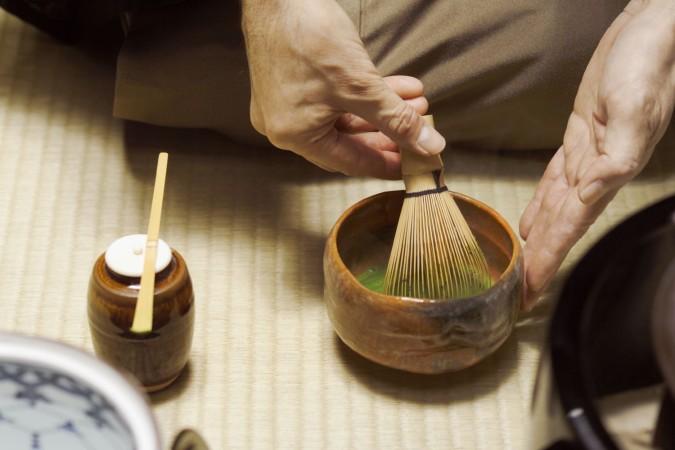
Japanese Tea Ceremony - © Learn Religions
Shopping in Kyoto
Kyoto offers a unique shopping experience, blending traditional crafts with modern boutiques. The shopping experience here offers something for everyone, from foodies and fashionistas to lovers of traditional crafts. Whether you're looking for high-end items or unique local products, Kyoto's diverse shopping options won't disappoint.
- Nishiki Market: Known as "Kyoto's Kitchen," Nishiki Market is a bustling marketplace where you can find a wide array of local foods, fresh produce, and unique souvenirs. It's a great place to sample Kyoto delicacies and buy ingredients to take home.
- Teramachi and Shinkyogoku Shopping Streets: These parallel shopping streets are filled with a mix of traditional shops, trendy boutiques, and souvenir stores. You can find everything from traditional crafts and antiques to modern fashion and quirky gifts.
- Kyoto Handicraft Center: This multi-story facility sells a variety of traditional Japanese crafts, such as pottery, textiles, and lacquerware. It's an ideal place to find high-quality souvenirs and gifts that showcase Kyoto's artisanal heritage.
- Kyoto Station: The massive Kyoto Station building houses a variety of shopping options, from department stores to specialty shops. The underground Porta mall and the above-ground Cube mall offer a diverse range of products, including fashion, electronics, and regional foods.
- Gion District Shops: Strolling through Gion, you'll find numerous shops selling traditional goods such as kimono, tea, and sweets. These shops often have a nostalgic charm, reflecting the district's historical ambiance.
- Arashiyama: This scenic area is not only known for its bamboo grove but also for its charming shops and cafes. You'll find unique souvenirs, local crafts, and delicious treats in the quaint streets of Arashiyama.
Explore the unique charm of Kobe, another must-visit place in Japan, in our article here.
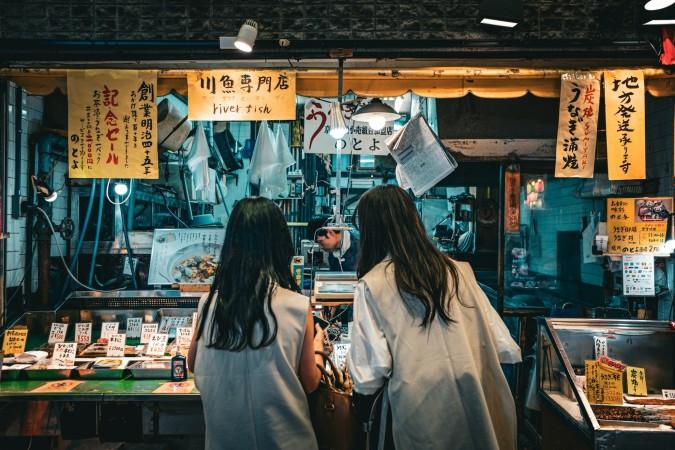
Shopping at Nishiki Market - © Owen Roth
Cultural Etiquette in Kyoto
Understanding and respecting local customs and etiquette is essential when visiting Kyoto. Pay attention to some key cultural customs is key to experience a trip to Kyoto to the fullest:
- Bowing: Bowing is a common gesture to greet and express respect in Japan. The depth and duration of the bow might change depending on the situation. Casual greetings generally need only a short bow.
- Taking Shoes off: It is customary to remove your shoes when entering someone’s home, traditional inns (ryokan), temples, and some restaurants. Always wear clean socks and look for designated areas to store your shoes.
- Silence in Public: Japanese culture values quiet and calm, especially in public places like trains and temples. Maintain a quiet voice and avoid loud talks. Silence your phone and refrain from making calls on public transportation.
- Gift Giving: Gift-giving is another important practice in Japanese culture for expressing respect. If you are invited to someone's home, bring a small gift, such as sweets or tea. It’s also common to offer a gift when thanking someone for their hospitality.
- Table Manners: When dining, use chopsticks properly and avoid sticking them upright in a bowl of rice, as this resembles a funeral ritual. Practice saying Japanese phrases such as "itadakimasu" before eating and "gochisousama deshita" after finishing your meal to show your respect and appreciation.
- Respect for Temples and Shrines: When visiting religious sites, dress modestly and follow any specific rules or guidelines. Refrain from taking photos in prohibited areas, and be respectful of worshippers.
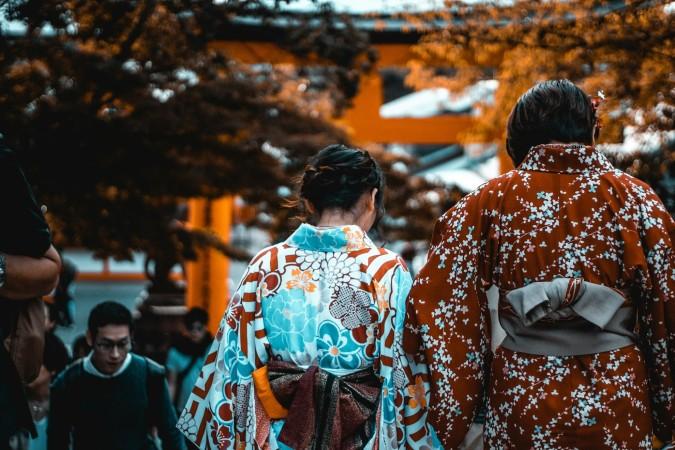
The beauty of Kimonos in Kyoto - © Cosmin Georgian
Essential Travel Information
Getting Around Kyoto
Kyoto offers a variety of transportation options that make it easy to navigate the city and explore its attractions. The city's efficient and reliable train system includes JR lines and private railway for traveling between Kyoto and Osaka. The extensive bus network covers major attractions and offers cost-effective day passes. The Kyoto Subway, comprising the Karasuma (north-south) and Tozai (east-west) lines, provides convenient access to central Kyoto. You can also rent a bicycle, which is a popular and enjoyable way to explore the city's flat terrain, with dedicated bike lanes and numerous rental shops available. Taxis are widely available and useful for short trips or carrying luggage, while many attractions are within walking distance, making strolling through historic districts a pleasant experience.
ATM & Banking Services
Accessing banking services and finding ATMs in Kyoto is straightforward, ensuring convenient access to cash and other financial services during your visit. ATMs are widely available, especially in 24-hour convenience stores which accept foreign debit and credit cards. Major banks and Japan Post Office ATMs provide bilingual instructions and accept international cards. Currency exchange services can be found at Kyoto Station, major hotels, and specialized exchange offices, making it advisable to exchange some currency before arrival and use ATMs for additional cash needs. While credit cards are accepted at many hotels, restaurants, and larger shops, smaller establishments and traditional markets may only accept cash, so carrying some cash is always a good idea.
Where to Stay in Kyoto
Kyoto offers a diverse range of accommodation options to suit all budgets and preferences, from luxury hotels to traditional inns and budget-friendly hostels.
- High-end hotels: Provide luxurious amenities and impeccable service, catering to travelers seeking comfort and elegance.
- Ryokan (traditional Japanese Inn): Staying at a ryokan provides a distinct cultural experience, with tatami mat rooms, futon beds, and traditional Japanese food, resulting in a genuine and unforgettable stay.
- Boutique hotels: Combine modern design with historic aspects to provide intimate and customized experiences.
Articles for you

Experience Aboard The RV Indochine II - A Mekong Cruise With Tweet World Travel
The RV Indochine II is a luxury river cruise ship, offering an unforgettable journey through many attractions along the Mekong River. Built in 2017, this upscale vessel combines colonial elegance with modern conveniences to create a comfortable yet stylish environment for its crew and passengers. The ship’s intimate size makes it ideal for those seeking a more personal cruising experience while exploring Vietnam and Cambodia rich culture, scenery, and heritage. Whether you're gazing at the landscape from your private balcony or enjoying authentic local cuisine, RV Indochine II promises an exotic adventure like no other.

Witness Stilt Fishing In Sri Lanka: An Eco-Tourism Experience
Sri Lanka, renowned for its stunning beaches and rich cultural heritage, harbors a unique tradition that has captivated travelers for centuries: stilt fishing. This ancient practice, passed down through generations of coastal communities, blends artistry with necessity, offering a glimpse into a way of life intimately connected to the island's coastal rhythms. Stilt fishing in Sri Lanka isn't merely a means to catch fish; it's a cultural emblem, embodying the resilience and ingenuity of Sri Lanka's fishing communities.

Make Your Trip Stress-Free With The Tweet Trip App
Embark on your next adventure with confidence by downloading the Tweet Trip App, available for both iOS and Android. This essential travel companion allows you to view your detailed itinerary, stay connected with your tour guide and fellow travelers, receive real-time updates, and provide feedback effortlessly. With features like in-app messaging, emergency assistance, and location sharing, the Tweet Trip App ensures you travel smarter, stay connected, and enjoy a seamless, worry-free journey. Get started today and make the most of your travel experience with Tweet World Travel.

Pedal Through Paradise: Unveiling Cambodia's Hidden Gems on Two Wheels
The gentle whir of bicycle wheels mingles with the distant chants of monks as you glide past emerald rice paddies stretching to the horizon. This is Cambodia - a sensory explosion waiting to be experienced on two wheels. At Tweet Tours, we believe there's no better way to immerse yourself in the Kingdom of Wonder than by bicycle.
Cambodia isn't just a destination; it's a living, breathing tapestry of ancient wonders, natural beauty, and vibrant culture. Our carefully crafted cycling tours take you beyond the typical tourist haunts, offering a unique perspective on this captivating country. Ready to clip in and discover the magic of Cambodia? Let's ride!

Trekking in the Himalayas: A Journey Through Nepal's Majestic Peaks
The Himalayas rise from the earth like colossal guardians, their snow-capped peaks piercing the sky in a display of nature's raw power and beauty. Nepal, nestled at the heart of this mountain range, serves as the gateway to some of the most breathtaking trekking experiences on the planet. Here, the air is crisp and thin, filled with the promise of adventure and the whispers of ancient tales.
With Tweet Tours, as you set foot on these hallowed trails, you're not just a traveler - you're a modern-day explorer, following in the footsteps of legendary mountaineers and age-old traders. Each step takes you further into a world where nature reigns supreme and human resilience is tested against the backdrop of some of the world's highest peaks.
From the moment your boots touch the ground in Kathmandu, you'll feel the pull of the mountains. The bustling streets of the capital, with their sensory overload of sights, sounds, and smells, soon give way to serene mountain paths where the only soundtrack is the crunch of gravel underfoot and the distant tinkling of yak bells.

Exploring Mui Ne's Wonders: Unique Attractions & Local Dishes
Nestled along the southeastern coast of Vietnam, Mui Ne emerges as a captivating gem, blending natural wonders with cultural richness. Renowned for its stunning landscapes and unique attractions, Mui Ne beckons travelers seeking both relaxation and adventure in equal measure. Mui Ne's renowned beach dunes, bustling fishing towns, and excellent local food await exploration at every turn.
The allure of Mui Ne lies not only in its pristine beaches and crystal-clear waters but also in its diverse range of activities catering to every traveler's whims. Whether you're drawn to thrilling water sports like kitesurfing and windsurfing on its dynamic shores or seeking tranquility amidst the picturesque Fairy Stream, Mui Ne promises an unforgettable journey filled with discovery.
